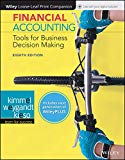
(a)
Financial Ratios: Financial ratios are the metrics used to evaluate the liquidity, capabilities, profitability, and overall performance of a company.
To compute: Earnings per share
(a)
Answer to Problem 13.2AP
Explanation of Solution
Given info: Income statement and
A portion of profit that an individual earns from each share is referred to earnings per share.
Formula:
Hence, earnings per share are $3.76.
(b)
To compute: Return on shareholders’ equity
(b)
Answer to Problem 13.2AP
Explanation of Solution
Given info: Income statement and Balance sheet
Formula:
Average common stockholders’ equity is determined by dividing opening and closing total common stockholders’ equity by 2. It is calculated as follows:
Hence, return on stockholders’ equity is 40.79%.
(c)
To compute: Return on assets ratio
(c)
Answer to Problem 13.2AP
Explanation of Solution
Given info: Income statement and Balance sheet
Return on assets determines the particular company’s overall earning power.
Formula:
Average total assets are determined by dividing opening and closing total assets by 2.
Hence, return on total assets ratio is 23.20%.
(d)
To compute:
(d)
Answer to Problem 13.2AP
Explanation of Solution
Given info: Income statement and Balance sheet
Current ratio is used to determine the relationship between current assets and current liabilities. The ideal current ratio is 2:1.
Formula:
Hence, current ratio is 1.86:1.
(e)
To compute: Accounts receivable turnover ratio
(e)
Answer to Problem 13.2AP
Explanation of Solution
Explanation
Given info: Income statement and Balance sheet
Accounts receivable turnover ratio is mainly used to evaluate the collection process efficiency. It helps the company to know the number of times the accounts receivable is collected in a particular time period. Main purpose of accounts receivable turnover ratio is to manage the
Formula:
Average net accounts receivable is determined by dividing the sum of opening and closing accounts receivable by 2.
Hence, accounts receivable turnover ratio is 17.14 times.
(f)
To compute: Average collection period
(f)
Answer to Problem 13.2AP
Explanation of Solution
Given info: Income statement and Balance sheet
This ratio is used to measure the number of days a particular company takes to collect their accounts receivables.
Formula:
Hence, the average collection period is 21.29 days.
(g)
To compute: Inventory turnover period
(g)
Answer to Problem 13.2AP
Explanation of Solution
Given info: Income statement and Balance sheet
Inventory turnover ratio is used to determine the number of times inventory used or sold during the particular accounting period.
Formula:
Average inventory is determined by dividing the sum of opening and closing inventory by 2. It is calculated as follows:
Hence, the inventory turnover ratio is 8.77 times.
(h)
To compute: Days in inventory ratio
(h)
Answer to Problem 13.2AP
Explanation of Solution
Given info: Income statement and Balance sheet
Days’ in inventory are used to determine number of days a particular company takes to make sales of the inventory available with them.
Formula:
Hence, the days’ sales in inventory ratio are 41.62 days.
(i)
To compute: Times interest earned ratio
(i)
Answer to Problem 13.2AP
Explanation of Solution
Given info: Income statement and Balance sheet
Times - interest earned ratio quantifies the number of times the earnings before interest and taxes can pay the interest expense.
Formula:
Hence, the times interest earned ratio is 17.1 times.
j)
To compute: Asset turnover ratio
j)
Answer to Problem 13.2AP
Explanation of Solution
Given info: Income statement and Balance sheet
Asset turnover ratio is used to determine the asset’s efficiency towards sales.
Formula:
Average assets are determined by dividing the sum of opening and closing assets by 2. It is calculated as follows:
Hence, the asset turnover ratio is 2.01 times.
k)
To compute: Debt to asset ratio
k)
Answer to Problem 13.2AP
Explanation of Solution
Given info: Income statement and Balance sheet
Debt to asset ratio is used by the company to determine how well the company is able to survive the losses without damaging the creditors’ interest. It is determined by dividing total debt and total assets.
Formula:
Hence, the debt to assets ratio is 41.24%.
h)
To compute:
h)
Answer to Problem 13.2AP
Explanation of Solution
Given info: Income statement and Balance sheet
Free
Formula:
Hence, the free cash flow is $14,000.
Want to see more full solutions like this?
Chapter 13 Solutions
Financial Accounting: Tools for Business Decision Making, 8e WileyPLUS (next generation) + Loose-leaf
- Can you explain the correct approach to solve this general accounting question?arrow_forwardCan you help me solve this general accounting problem using the correct accounting process?arrow_forwardCan you help me solve this financial accounting question using valid financial accounting techniques?arrow_forward
- The difference between total revenues and total variable costs is known as ______________ Contribution margin Gross margin Operating income Fixed costsarrow_forwardFixed cost per unit decreases when ______________ Production volume increases. Production volume decreases. Variable cost per unit decreases. Variable cost per unit increases.arrow_forwardPlease provide the correct answer to this general accounting problem using valid calculations.arrow_forward
- I need the correct answer to this financial accounting problem using the standard accounting approach.arrow_forwardCost of production report is a ______________ Financial statement Production Process report Order Sheet None of abovearrow_forwardCan you guide me through solving this financial accounting problem using proper techniques?arrow_forward
 Financial Accounting: The Impact on Decision Make...AccountingISBN:9781305654174Author:Gary A. Porter, Curtis L. NortonPublisher:Cengage Learning
Financial Accounting: The Impact on Decision Make...AccountingISBN:9781305654174Author:Gary A. Porter, Curtis L. NortonPublisher:Cengage Learning Managerial AccountingAccountingISBN:9781337912020Author:Carl Warren, Ph.d. Cma William B. TaylerPublisher:South-Western College Pub
Managerial AccountingAccountingISBN:9781337912020Author:Carl Warren, Ph.d. Cma William B. TaylerPublisher:South-Western College Pub Financial AccountingAccountingISBN:9781305088436Author:Carl Warren, Jim Reeve, Jonathan DuchacPublisher:Cengage Learning
Financial AccountingAccountingISBN:9781305088436Author:Carl Warren, Jim Reeve, Jonathan DuchacPublisher:Cengage Learning Financial And Managerial AccountingAccountingISBN:9781337902663Author:WARREN, Carl S.Publisher:Cengage Learning,
Financial And Managerial AccountingAccountingISBN:9781337902663Author:WARREN, Carl S.Publisher:Cengage Learning, Financial AccountingAccountingISBN:9781337272124Author:Carl Warren, James M. Reeve, Jonathan DuchacPublisher:Cengage Learning
Financial AccountingAccountingISBN:9781337272124Author:Carl Warren, James M. Reeve, Jonathan DuchacPublisher:Cengage Learning




